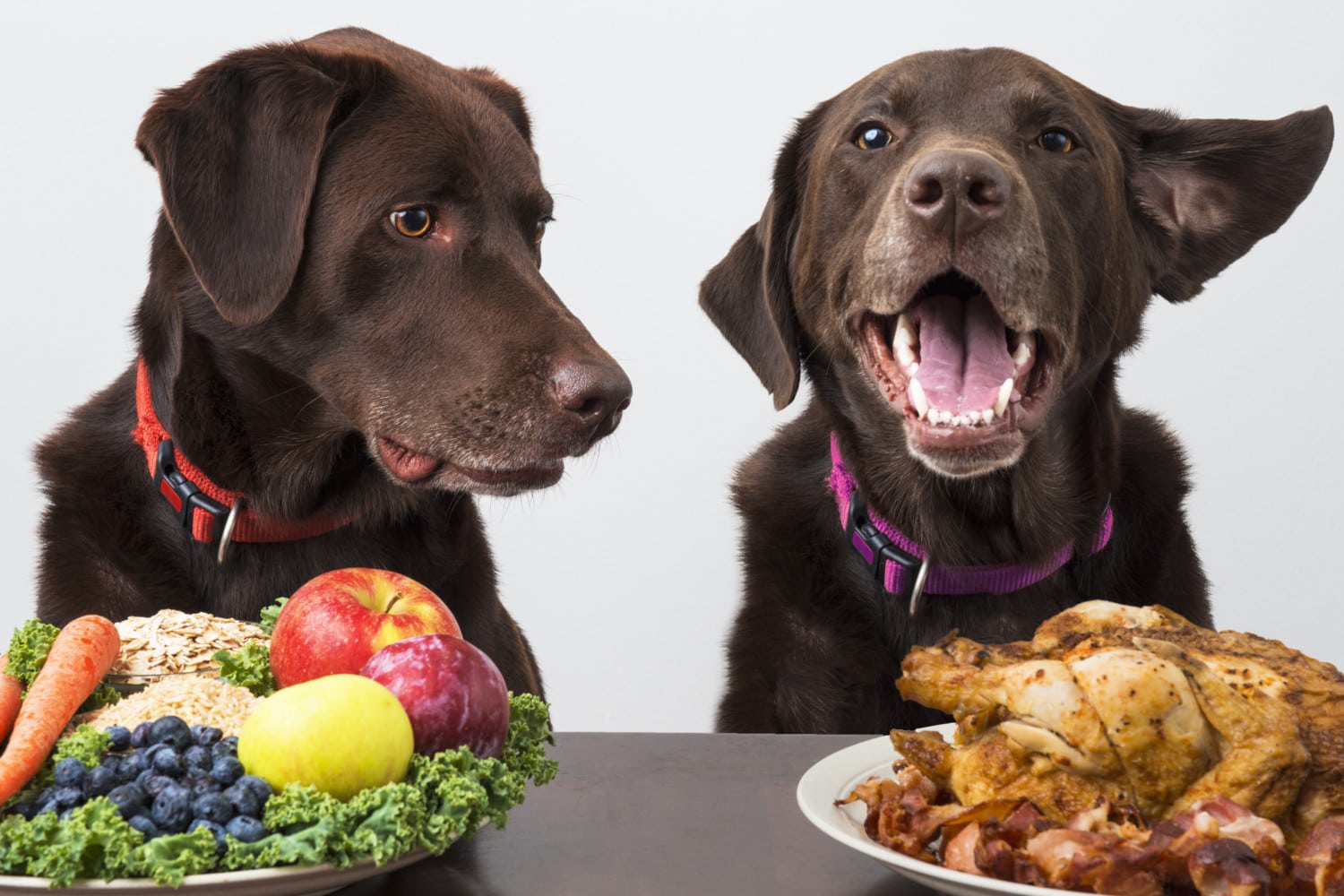It’s a doggy dream come true: hand-crafted, homemade food made with real, human-style ingredients and served with love. Perhaps it’s even plated on ceramic and garnished with a sprig of curly parsley.
Maybe the idea of feeding your dogs at the table seems a bit over the top. But as more Americans become pet owners, folks are ditching traditional processed dog chow and figuring out new ways to feed their furry family members.
Studies have shown that a highly processed diet can have ill effects for pups as they age (just like with humans). And with people increasingly attracted to healthy eating, it makes sense they’d try to include their canine companions in the effort.
Not to mention that some dogs have trouble tolerating store-bought, commercially prepared dog kibble. Whether it’s allergies, skin conditions or a chronic illness like diabetes, sometimes a custom diet of fresh, cooked foods may be a better alternative.

Consider Nutrition
If you’re interested in taking the plunge into homemade dog food for Fido, recipes abound! But make sure you check with your vet before you purchase a big haul of ingredients.
Though humans and dogs have a lot in common food-wise, the American Kennel Club warns that some homemade dog food recipes may not be nutritionally adequate for all dog breeds, sizes and life stages.
“We generally don’t recommend homemade diets for a dog less than 1 year old. If young dogs don’t receive the appropriate amount of calcium and phosphorus, significant bone abnormalities may result,” said American Kennel Club’s chief veterinarian Dr. Jerry Klein in an AKC article on homemade foods. “Pregnant and lactating dogs also have unique dietary requirements that may not be addressed by a recipe found on the internet.”
Commercial foods may be nutritionally complete and balanced even if they don’t use whole ingredients. You may wish to consider adding a dietary supplement, or adding homemade dog food to kibble to make sure your pup is getting the right amounts of the nutrients he or she needs, including protein, carbohydrates, fiber, and fat.

What Else You Should Know About Homemade Dog Food
There are other trip-ups to consider. For instance, some dog food recipes may lack clear instructions.
“Most general recipes provide vague instructions for ingredients or preparation,” board-certified veterinary nutritionist (and vet) Dr. Jennifer A. Larsentold the AKC. “This leaves the owner to interpret what type of meat to use, or which supplement product to buy.”
It also takes time to make homemade dog food, along with extra money to buy meat and other items you need if you generally just feed kibble. You’ll want to know you have the resources for adding this to your to-do list. And you need to make sure you can store it properly — in the fridge for a few days, or in the freezer in an airtight container for up to six months.
And, of course, there’s a list of foods that are just fine for humans, but potentially poisonous for dogs. Grapes, raisins, onions, garlic, macadamia nuts and, of course, chocolate can cause problems ranging from diarrhea to death.
In any case, run any new recipe ideas by your vet before whipping up a batch. If your dog is experiencing symptoms related to an illness or disorder, your vet may recommend a consult with a veterinary nutritionist. The nutritionist will also have ideas on how to create the most nourishing doggy diet.
Also, note that at this time, the scientific community, the Centers for Disease Control and Prevention, the Center for Veterinary Medicine, and the U.S. Food and Drug Administration as well as many pet advocacy organizations are united in advocating against feeding dogs raw foods, which have high bacteria counts and may lead to illness.

Switching Your Dog’s Diet
When you do land on a homemade dog food recipe that checks all the boxes — nutritionally complete and balanced and free of allergens, irritants or inadvertent poisons — there’s one more hurdle: Switching your pup from his usual diet to a very different one.
It’s a familiar process to anyone who’s already done it, but the gist is that it should be done gradually. A too-quick change can upset a sensitive tummy, so take it slow (unless your vet says to just go for it — another reason to check in before switching).
Over the course of a week, switch out more amounts of the old food and add in more of the new. You can go even more slowly if your dog has a history of diet issues, or if your dog begins to show symptoms of stomach upset.
The below homemade dog food recipes can serve as a starting point. These examples of nutritionally complete dog food recipes could become favorites with your darling doggo.

How To Find The Right Homemade Dog Food Recipes
Homemade dog food recipes can be found online easily. However, don’t just look at the first recipe you find and call it a day. You’ll want to make sure any ones you decide to use are nutritionally complete and/or vet approved, and then you need to follow them exactly.
For example, this AllRecipes.com version is your basic online recipe. It’s a mix of ground turkey, rice and vegetables with a bit of dried rosemary. There’s no guarantee your dog is getting the proper nutritional profile and right amounts, so you’ll have to continue feeding kibble to ensure proper nutrition. Instead, consider the following vet-approved recipes.
Northwest Holistic Pet Care’s vet-approved recipe also includes turkey, but specifically includes thigh and organ meat for better nutrition. It also requires a calcium citrate supplement, which it says is not optional.
The MSPCA-Angell Homemade Diet recipe was devised by a vet at the Massachusetts Society for the Prevention of Cruelty to Animals-Angell Medical Center. It’s targeted to 30-pound dogs with no health concerns, but the MSPCA also published recipes for 15-pound and 60-pound pups. Cats, too!
The MSPCA recommends using a food scale to measure the ingredients most accurately: Blend together 130 grams of cooked, dark-meat chicken, 320 grams of cooked white rice, 25 grams mixed vegetables, 10 to 15 grams of vegetable oil and 10 grams of Balance It Canine, the organization’s preferred nutrition supplement.
This makes one day’s worth of food. Make sure the items are well combined so your dog doesn’t try to pick out his favorite bits and leave the rest. And a supplement completes the balance of nutrients in the diet — as with Northwest Holistic’s version, this is not optional.

Still Need Help?
If you still need some guidance, try using the Balance.It tool to start building a homemade dog food recipe personalized for your dog’s needs. Created by the folks who make the supplement recommended in the above recipe, the tool lets you plug in details about your best bud, then generate a few recipe ideas you can run by your vet.
I put in numbers for my angelic Chihuahua, Uma, a 3-year-old neutered male who weighs about 9 pounds. In seconds, the tool presented multiple dog food recipes with a variety of different ingredients, from chicken breast to tilapia.
One variation: Ground chicken, an omega-3 liquid, corn oil, brown rice and a fistful of raw veggies like spinach, carrots, peas and sweet peppers. (Which, uh, sounds pretty tasty to be honest.)
Each recipe includes the Balance.It supplement — that’s what they’re selling after all — but, again, supplementation is necessary to ensure your dog gets everything they need from a homemade diet.
This also bears repeating: Make sure you talk to a vet or veterinary nutritionist before making any dietary changes. Your dog’s individual needs might vary from a generic, one-size-fits-all recipe.

Now, get researching! Lots of tail-wags and happy dances are coming your way.
This story originally appeared on Simplemost. Check out Simplemost for additional stories.


